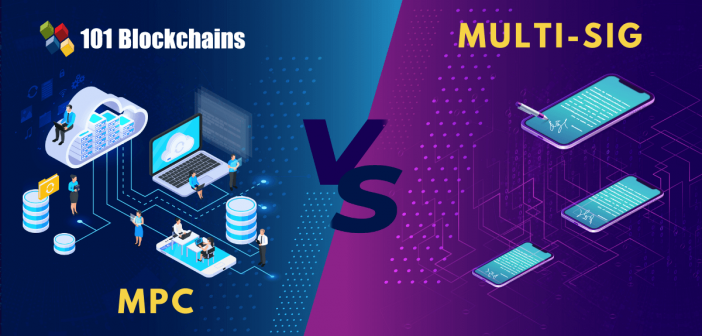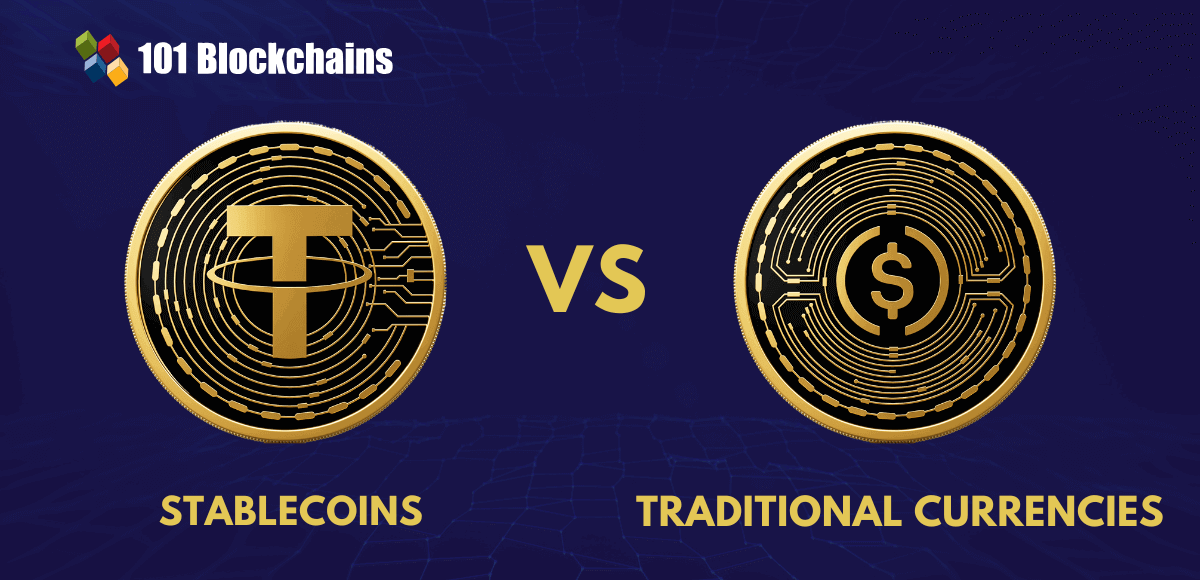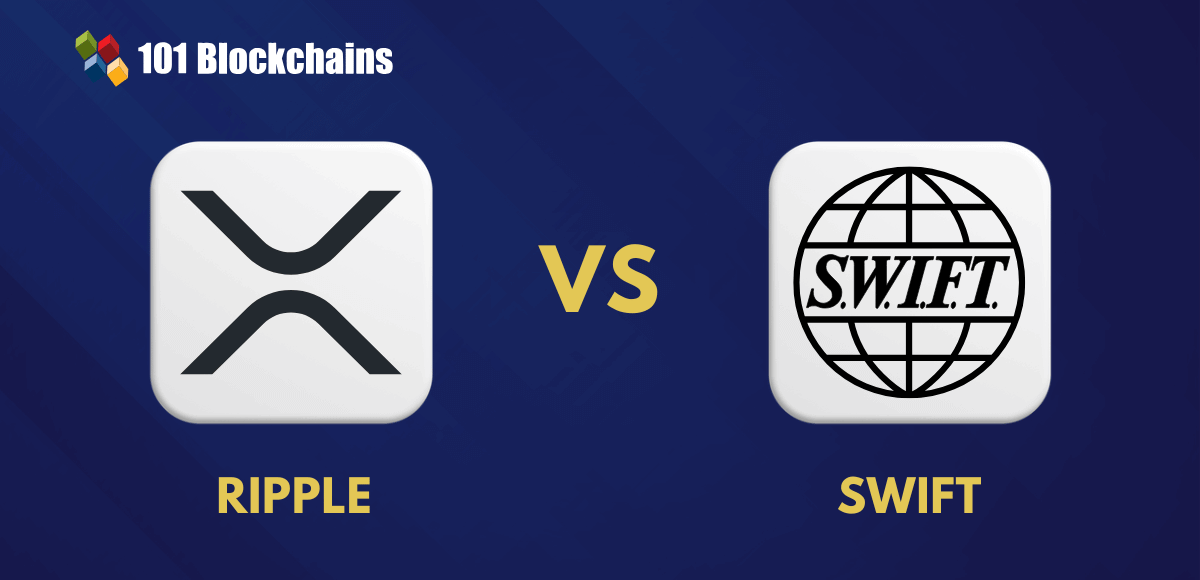Learn how blockchain truly works, master key definitions, and uncover what makes smart contracts so "smart." Dive into the fundamentals, gain valuable insights, and start your blockchain journey today!

- Comparisons
Gwyneth Iredale
- on September 29, 2021
A Comparison between MPC and Multi-Sig
The continuously growing levels of digital asset adoption among enterprises have spurred the need for secure and efficient instruments for enabling scalability and operations in accordance with growing demand. With security being an important concern, the selection of an ideal approach is highly crucial for ensuring desired security levels. At this point in time, the comparison between MPC vs Multi-sig has become a prominent facet in the crypto world.
Some consider multi-signature or multi-sig wallets as the secure option, while others state that Multiparty Computation offers better security. So, which one is better? Let us reflect on a comparison between both of them to find out the suitable option. The following discussion offers a detailed impression of multiparty computation and multi-signature wallets alongside focusing profoundly on their differences.
Multi-signature and MPC are the two most common choices in technology for the security of private keys. Before finding an outline of the differences between MPC vs Multi-Sig, it is important to understand the technologies.
Build your identity as a certified blockchain expert with 101 Blockchains’ Blockchain Certifications designed to provide enhanced career prospects.
What is Multi-sig?
Multi-signature basically refers to a digital signing process that can enable multiple users to sign transactions like a group. The multi-signature address is generally linked to multiple private keys. Interestingly, multi-sig addresses came to the forefront in 2012, when Bitcoin introduced an alternative for single key addresses.
During the same time, a distinct type of address referred to as pay-to-script hash or P2SH found a clear definition. In addition, P2SH also involved standardization with possibilities for recognition by verifying that they start with a ‘3’ rather than ‘1’. The most interesting functionality with P2SH addresses refers to the ability to require multiple private keys for ensuring transactions.
Prior to the arrival of multi-sig wallets, the most common approach for storing digital assets involved the use of a single private key. Individuals with access to the private key could access the digital assets associated with the specific key. Now, the multi-signature wallet introduced an additional security layer by developing wallets that need a signature from multiple keys.
It is clear that the multi-signature approach could offer reliable solutions for many issues in single-signature wallets. However, multi-sig wallets come with a prominent setback in the form of protocol dependence. In order to know ‘What’s difference between MPC and Multi-sig,’ you must know the reasons for introducing multiparty computation.
Want to become a Cryptocurrency expert? Enroll Now in Cryptocurrency Fundamentals Course
Where Did Multi-signature Falter?
Multi-signature does not fit well with all crypto protocols. Therefore, multi-signature wallet providers experience many issues in supporting new chains securely. Wallet providers must implement different codes for each on-chain multi-signature solution. On the other hand, a failed multi-signature implementation could lead to prominent issues. For example, inappropriate implementation of the Multi-sig Parity Wallet resulted in a $30 million Ethereum wallet hack. The Parity Wallet was also hacked once again, and this time, some customers had to lose almost $300,000 worth of digital assets.
Furthermore, the multi-signature approach could not provide the desired operational flexibility for enabling the growth of organizations. As an enterprise grows, users should adapt to new methods to access and transfer digital assets. You can think of possibilities such as changing the number of employees required for signing a transaction. Some of the other scenarios might include the addition of new key shares with the addition of new employees or revoking key shares with employees leaving. It is important to note that multi-sig addresses can present notable setbacks in such scenarios.
Here’s a detailed guide to know the features and comparison of Private Key Vs Public Key.
What is MPC (Multiparty Computation)?
Multiparty Computation or MPC evolved as a possible solution for resolving the prominent challenges for private key security in present times. Multiparty computation takes away the concept of a single private key as it does not involve collecting a single private key in its entirety. You don’t have a single private key at the time of first creating the wallet or the creation of the actual signature. Multiparty computation helps in addressing the problem of a single point of failure for the private key. MPC employs the following steps for ensuring relief from the burden of a single point of failure.
- Every endpoint randomizes the individual secrets, which are never shared among them.
- Each endpoint participates in a protocol for creating a decentralized wallet, which enables them to compute the wallet address or public key related to the collection of individual private shares.
- Upon signature requests for blockchain transactions, a minimum amount of endpoints or quorum (3 at the minimum) participate in a distributed signature process. All endpoints have to validate the transaction and policy individually, followed by signing the transaction.
Since the private key does not stay on a particular device at a specific instance of time, MPC can offer the additional layer for private key protection. Furthermore, the distributed nature of multiparty computation enables team members to establish the need for multiple verifiers for transactions. In addition, multiparty computation also offers the flexibility for ongoing modification and maintenance in the signature scheme.
Differences between Multi-sig and MPC
The basic definitions of Multiparty Computation and Multi-signature approaches for private key security provide a lot of insights on both. As a matter of fact, you can definitely find the answer to ‘Is multisig more secure?’ by reflecting on the additional security layer with multiparty computation. While security is one of the fundamental benchmarks for comparing multi-signature and multiparty computation approaches, there are many other aspects for comparison. Let us take a look at some of them here.
-
Compatibility
One of the foremost aspects in an MPC vs Multi-sig comparison, apart from security, would point towards compatibility. The bad news for multi-signature is that it supports only a few blockchain protocols. On the other hand, multiparty computation is completely blockchain agnostic and can work with almost any ledger. Multi-signature does not offer adequate support for decentralized apps and DeFi services. On the contrary, MPC delivers a simple address that works effectively with almost any type of decentralized application or service.
In addition, multiparty computation offers ease of deployment on desktop, mobile, or any server device with flexible modification for authorization policies. As a result, the hardware security module or HSM operators could access only the blockchain addresses. The infrastructure changes would not have any effect on the HSM operators. However, multi-signature wallets can create issues for HSMs due to their lack of support for blockchain protocols.
Curious to learn about blockchain implementation and strategy for managing your blockchain projects? Enroll Now in Blockchain Technology – Implementation And Strategy Course!
-
Privacy
Another crucial aspect in answers to ‘What’s difference between MPC and Multi-sig’ points towards the privacy factor. If a multi-signature user shares their address with someone or on the internet, then it is possible to trace and transactions with the address and also relate them to the user.
On the contrary, multiparty computation leverages secrets in transaction signing. The secrets are visible to the participants, albeit without any identification of the owner of the secret. Here is an outline of the process in multiparty computation, which can help you understand its impact on privacy.
- Users receive notifications regarding a specific transaction
- Go through the process of multi-factor authentication
- Take a good review of the transaction
- Validate or decline the transaction
Secrets in multiparty computation could make it difficult to find out the ones used for signing a specific transaction. Although it can present a formidable setback for mainstream adoption of MPC in corporate organizations, anonymity definitely serves prolific value.
Want to understand the critical data privacy issues for blockchain solutions? Enroll Now in Blockchain and Data Privacy Masterclass
-
Flexibility
The discussion on ‘Is multisig more secure’ never sees the light of the day with the definition of multiparty computation. With multiple verifiers for signing transactions, multiparty computation brings an additional layer for private key security. However, does it offer the desired flexibility? In the case of the multi-sign approach, any changes in the addresses require modifications in the code.
Therefore, enterprises have to rely on third-party IT services for the daily IT tasks alongside additional time and money investments. Furthermore, multi-sig also presents another setback with restricted flexibility in support for new quorum authorization policies. On the contrary, you have an unlimited number of parties in a quorum. In addition, you get the opportunity to implement any rules for signing a transaction, such as the amount of money, time of day, type of payment, geographical location, or other factors.
-
Speed
The first thing you note about multi-signature transactions is the on-chain signing alongside the need for confirmation. As a result, you can clearly find multi-signature transactions on the downside in MPC vs Multi-sig comparisons on the basis of speed. The off-chain approach in multiparty computation enables better improvements in the speed of transactions. In the case of multi-signature transactions, scripts have to include more data for including metadata regarding every signer.
As a result, the time for processing a new block increases and, so does the final cost for the end-user. On the other hand, users process their secrets independently with a multiparty computation approach, thereby ensuring the availability of devices. Secrets in multiparty computation support the anonymous transaction signing. Furthermore, the lack of data also ensures a plausible reduction in transaction time and costs.
You can discover a clear overview of the differences between multi-sig and multiparty computation with the following comparison table.
| Criteria | Multiparty Computation | Multi-sig |
|---|---|---|
| Compatibility | Multiparty computation uses a simple address which works seamlessly with different decentralized services and solutions alongside ease of deployment on multiple devices with flexibility for modifying authorization policies. | Multi-sig approach only provides support for specific blockchain protocols. |
| Privacy | Multiparty computation approach leverages secrets for safeguarding the identity of the parties involved in signing the transaction. | Multi-sig users expose their privacy when they share their address with anyone or on the internet. |
| Flexibility | MPC supports the unlimited number of parties in quorum along with flexibility for specifying the rules for transaction signing. | Changes in addresses require changes in the code in a multi-sig approach alongside restrictions on quorum authorization policies. |
| Speed | Off-chain signing approach along with secrets supporting the anonymous signing of transactions ensure reduction of transaction time. | On-chain signing and inclusion of additional data in scripts increases the time for processing transactions. |
Conclusion
On a final note, it is clearly evident that multiparty computation comes out as a clear winner in the MPC vs Multi-sig debate. The foremost advantage of multiparty computation over the multi-signature approach in private key security is security itself. Multiparty Computation ensures that the private key is never stored in one place and removes the concept of a single private key as a whole entity.
As a matter of fact, multiparty computation is a favorable instrument to replace the multi-signature approach due to its valuable benefits. You can have better privacy, compatibility, speed, and flexibility advantages with multiparty computation. At the same time, it is also unreasonable to disregard the use of multi-signature wallets completely. Learn more about multi-signature wallets and multiparty computation now.
*Disclaimer: The article should not be taken as, and is not intended to provide any investment advice. Claims made in this article do not constitute investment advice and should not be taken as such. 101 Blockchains shall not be responsible for any loss sustained by any person who relies on this article. Do your own research!






